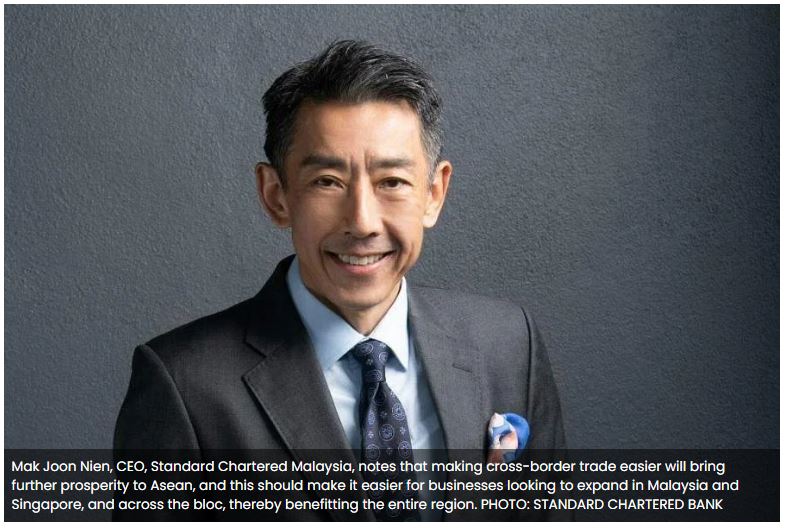Malaysia and Singapore – a corridor key to Asean’s growing prosperity
THE agreements signed by Malaysia and Singapore in January this year on the green and digital economies are the latest indication of the potential that these South-east Asian neighbours have – with their shared historical, geographic, economic, cultural and family ties – to collaborate in boosting prosperity both at home and across the region.
While Asean has grown significantly in recent decades, there is still enormous potential – and Malaysia and Singapore will be at the heart of attaining it.
Data from the International Monetary Fund showed that Malaysia and Singapore contribute nearly a quarter of Asean’s total gross domestic product (GDP), with the projected combined GDP of US$914 billion in 2023 expected to climb to US$1.15 trillion by 2027.
This economic heft is underpinned by robust mutual trade. Each is the other’s second-largest trading partner, with trade expected to total about US$110 billion in 2022. In addition, Singapore is Malaysia’s second-largest foreign investor, with US$12 billion invested in 2021.
The future looks promising for the Malaysian-Singapore corridor and, given the way economic and trade benefits ripple across the region, for Asean itself.
That said, what is likely to be the key drivers for investment, and how can this bilateral relationship boost further growth in Asean?
Benefitting from a shifting world order and growth themes
As the only international bank with a footprint in every Asean nation and with a presence for over a century in the bloc’s five largest economies (Indonesia, Thailand, Vietnam, Malaysia and Singapore), Standard Chartered is well-placed to consider the factors driving opportunities for corporates in Malaysia and Singapore, and across the region.
First is the shifting world order – specifically, the retreat of globalisation and a stronger focus on national and regional collaboration. Both nations, with their educated populations, excellent infrastructure and resilient politics, will benefit. Asean, too, is gaining as companies seek additional bases in the region, heartened by the prospects of it moving up one notch to become the world’s fourth-largest economy by 2030.
Second, the agreements on the green and digital economies should drive growth and investment in areas such as low-carbon solutions, electronic payments, trade facilitation, and digitising industries and small businesses. Those benefits should become apparent relatively soon, as bilateral agreements like these are quicker to execute.
Third, Malaysia and Singapore stand to benefit strongly from the regional growth themes of trade, investment, digitisation and sustainability; and sectors such as construction and infrastructure; consumer products; pharmaceuticals and healthcare; and digital and e-commerce.
These sectors alone are expected to enjoy compound annual growth rates of 10 per cent to 12 per cent in the coming years, based on a US$2 trillion gross sector output annually for the region.
Positive though these drivers are, it will not be plain sailing. For instance, many small- and medium-sized enterprises (SMEs) in Asean seeking opportunities with multinationals or to enter markets in the Organisation for Economic Co-operation and Developmen are not environment, social, governance (ESG) ready.
As that is fast becoming a prerequisite to integrate into regional and global supply chains, SMEs will need to improve compliance with ESG requirements should they wish to work with brands that pay heed to such matters.
Advantages that transcend borders
Companies that pursue that path will benefit more from the expected trade growth. Standard Chartered’s Future of Trade 2030 report projects that trade export value from Singapore to Malaysia will more than double to US$92.3 billion in 2030 from 2020, driven by Malaysia’s growing advanced manufacturing capabilities, e-commerce growth and robust economic ties.
At the same time, Singapore is expected to remain the second-largest market for Malaysian exports, accounting for 17 per cent of total exports by 2030.
This cross-border dependency stems from advantages specific to each. Singapore’s deep and liquid financial markets, for example, are crucial for companies looking to expand, while the country boasts opportunities in healthcare, consumer goods, construction and real estate, as well as in renewable energy.
For its part, Malaysia’s key growth sectors such as electrical and electronics, healthcare, automotive and e-commerce present opportunities for companies seeking to diversify their supply chain and operations in Asean.
The country’s political stability despite multiple changes of government, its resilient economy, robust industry sectors, and established ecosystems in areas such as Penang – whose value was emphasised during Covid-19 – are clear advantages.
All of this positions Malaysia well. In addition, for Singapore companies, land and natural resources in an adjacent nation that is culturally similar are important draws. For others, in Asean and beyond, Malaysia’s robust and well-established ecosystems, reliable energy and excellent infrastructure are of enormous value.
Forging new paths and strategic partnerships
Given the centrality of Malaysia and Singapore to the Asean market, enhanced collaboration will present a wealth of opportunities for businesses from both nations and beyond to forge new paths and strategic partnerships.
Part of that will be seen in efforts to enhance cross-border trade. The digital economy framework signed by Malaysia and Singapore focuses on boosting digital cooperation to improve trade facilitation, cross-border data flows and electronic payments.
As a bank that offers cross-Asean connectivity, Standard Chartered understands the value that clients place on services such as multi-currency offerings and cash management, allowing them to manage cross-border foreign exchange exposure in real time.
Making cross-border trade easier will bring further prosperity to Asean, and this should make it easier for businesses looking to expand in Malaysia and Singapore, and across the bloc, thereby benefitting the entire region.
That, ultimately, will allow Standard Chartered to deliver what it does best: supporting businesses with on-the-ground advisory and innovative financial solutions that meet their local and cross-border needs in this dynamic region.
Source: https://www.businesstimes.com.sg/international/global/malaysia-and-singapore-corridor-key-aseans-growing-prosperity


 Thailand
Thailand




